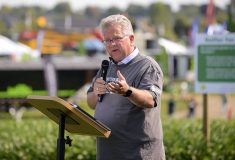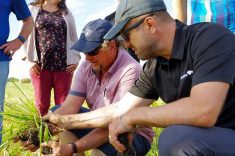Some farmers say they’ve already done their bit for climate change through reduced tillage, but it’s a dubious argument, according to the National Farmers Union (NFU).
“We should not become confused by claims that we can somehow fix the climate crisis by pulling carbon out of the atmosphere and ‘sequestering’ it in soils,” says an NFU discussion paper. “This is a false solution for many reasons.”
The paper says storing carbon in the soil is good because it builds organic matter and improves soil quality. But its value for reducing carbon in the atmosphere is limited.
Read Also

Mazergroup’s Bob Mazer dies
Mazergroup’s Bob Mazer, who helped grow his family’s company into a string of farm equipment dealerships and the main dealer for New Holland machinery in Saskatchewan and Manitoba, died July 6 from cancer.
For example, soil-stored carbon can easily be released due to warmer temperatures or drought, the paper says.
“Most important, soil carbon sequestration occurs only for a limited time, perhaps two to four decades,” the paper says, and that’s if soil isn’t cultivated. “After that, sequestration slows or stops as soils become ‘saturated’ and a new equilibrium is reached between the rate at which carbon is added via plant biomass, root exudates, etc., and the rate at which soil micro-organisms consume organic matter and release carbon as CO2. Seen another way: the maximum amount of soil carbon that farmers can sequester via enhanced management is roughly equal to the amount released previously due to suboptimal management. What we call ‘sequestering carbon’ is, in many cases, the return of carbon that previous farming practices released.”
But that doesn’t mean farmers shouldn’t be using no till or planting perennial forage, Qualman said in an interview Nov. 27.
“What we shouldn’t do is see it as an offset for emissions,” he said. “You shouldn’t count emissions on one side and sequestration on the other and net them out. It’s really two different processes. We completely support all the grazing techniques and cropping techniques that will bring the soil back to the health and carbon density it had generations ago, but for a lot of reasons we shouldn’t just net those two out because over time the dynamics are very different. You put carbon in the atmosphere, it stays there for 1,000 years. You put carbon in the soil it’s less clear what happens.”
The United Nations and other emission-accounting bodies only count increases, if any, in the rate of soil carbon sequestration above the relatively high rates that existed in 2005, the paper says.
“For the most part, sequestration won’t count.”




















